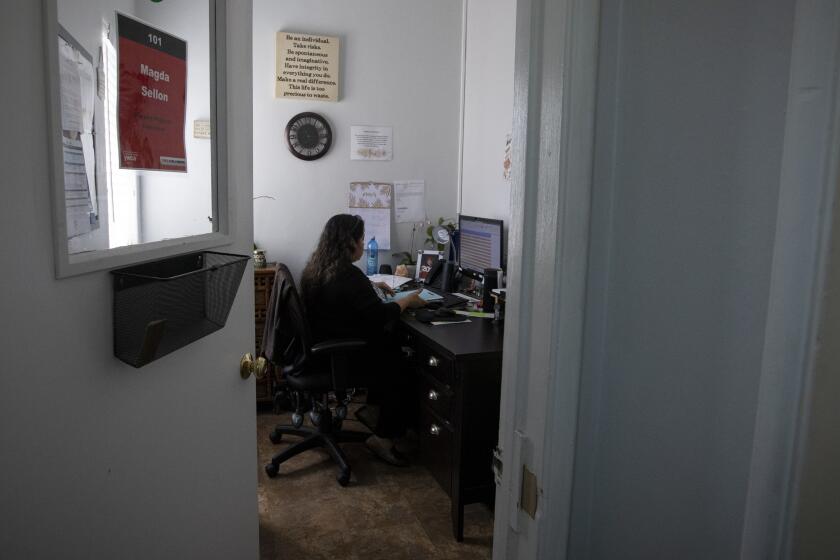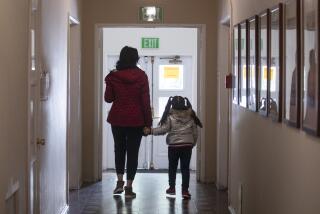Commentary: Trapped at home — coronavirus could be disastrous for domestic violence victims

- Share via
I’ve been thinking a lot about a woman I met some years ago. She lives in San Diego; her boyfriend once held her hostage for three days. He first split open her lip, and then he seemed to be angry at her that she had a split lip and he took an Adidas shoe and beat her on the back. He choked her when she was in the shower. He threw things at her and held a knifepoint to her eye.
She was in decent shape and she wondered, during those three days, if she could get out of the house and outrun him. She wondered where she might run and who might help. Shame and fear held her in place.
Less than five miles away from where she was being held, in the only training of its kind in the country, police officers learn to address hostage situations in the context of domestic violence. Thanks primarily to film and television, most of us imagine bank heists when we hear the word “hostage.” In fact, though reliable statistics are hard to come by, domestic violence episodes comprise somewhere near 80% of all hostage situations in the United States.
Domestic violence victims in a “worst-case scenario” during coronavirus outbreak, providers say
This matters a great deal because those who take hostages in banks generally want to live, whereas men — and it’s nearly always men — who take their partners hostage do not share this incentive. Often, they care little whether anyone lives or dies, including themselves; what they want is to maintain control.
The woman I met in San Diego was not poor. She was not uneducated. She was the primary breadwinner. She was beautiful, and young, and smart. After three days, she convinced her partner that they needed supplies. He drove with her to a convenience store. She sat in the passenger seat while he shopped. He’d taken her phone and her keys.
She thought of running, but she was barefoot. How far would she get? Where would she go?
When they pulled back up to their apartment, she saw her neighbors getting into their minivan. She did not think. She bolted, barefoot, and dived into the open door of the minivan.
Amie Harwick, once engaged to ‘The Price Is Right’s’ Drew Carey, was killed at her home. Ex-boyfriend Gareth Pursehouse is charged with her murder.
This is what I’ve been contemplating as communities across the country begin to recommend — and in the case of cities like Los Angeles, mandate — social distancing to slow the spread of coronavirus: What if her neighbors hadn’t been out there, getting in the car? What if she’d fled to a house that did not answer the door? What if she’d fled to the emergency room and found it so overwhelmed it could not address her needs? There was eventually a five-hour standoff between the police and her boyfriend, who had barricaded himself inside their apartment.
People like her are the ones I’m thinking about during this pandemic — those for whom the world outside might be safer than their own home. What if her already-violent boyfriend could not attend his Ironman trainings? Or watch sports to decompress? What if there were no reason for her coworkers to wonder why she wasn’t at work? What happens when the demands of social distancing mean the most vulnerable in our society might be distanced right out of existence?
Where can they go in the age of coronavirus?
Who keeps them safe in a world of unmitigated dangers?
In times of natural disasters and great social upheaval — Hurricanes Katrina and Sandy, for example — the systems we’ve created to aid domestic violence victims can get easily overwhelmed. Nurses qualified to do forensic exams are already being pulled into more general care or into emergency rooms. At the same time, those nurses tend to be women. They are more likely than men to be caring for aging parents. They are more likely to shoulder childcare burdens. And in this moment, many of them — like me — have children who are now home from school.
In communities across Southern California and throughout the country, coronavirus fears have driven an increase in gun and tactical body armor sales. And the research is unequivocal; guns in the home of an abuser increase the chances of homicide by at least five times.
All of this is happening in a country where domestic violence homicides have steadily risen since 2010 and, in fact, have spiked since 2017.
National and community crises historically have led to increased reports of domestic abuse. During the Deepwater Horizon oil spill in the Gulf of Mexico, the National Domestic Violence Hotline saw a 13% increase in calls from the Gulf area from April to June 2010. New Orleans and Lafayette, two of the largest communities affected by the spill, saw increases to their hotlines of 81% and 116%, respectively, during that same period. Hurricane Katrina too saw domestic assaults against women nearly double, and both men and women reported increases of psychological abuse.
This all sounds grim, but many of these situations involve couples who were not in healthy relationships to begin with. On a call from her Baltimore home, Jacquelyn Campbell, a professor from the Johns Hopkins School of Nursing and the country’s foremost researcher in domestic violence, was careful to point out that someone who is not psychologically or physically abusive before a crisis like coronavirus is not going to suddenly become violent. “This is not like anything I’ve lived through,” she said, “and my hypothesis is that any kind of horrific anything externally can exacerbate domestic violence.”
Campbell created a danger assessment decades ago that many programs now use to try to predict a domestic homicide before it happens. The stressors identified that make a situation lethal are the same whether we are in a pandemic or not: guns in the home, forced sex, unemployment and, most notably, prior incidents of domestic violence.
But the research on how domestic violence might be affected by our current situation simply does not exist. When an entire society shuts down, when children are home all day from school, when sports and gyms and social activities are all canceled, when friends can’t leave their own families to help, when places of worship are shuttered, when everything that ever tempered a violent situation is suddenly, terrifyingly, no longer available. What happens then?

Campbell says measures like the House of Representatives’ legislation to offer financial relief might go a long way in quelling the danger and maintaining healthy families. She also says domestic violence victims often tend to have compromised immune systems given the stress they face daily and as such should be eligible for coronavirus testing sooner than the general population. Shelters should have testing kits early for the same reason.
We can try to prepare, and we can try to predict. But we are in foreign territory here, a countrywide state of emergency, a pandemic moving with more speed and temerity and adaptability that we have seen in a century — since, in fact, a time before we had data and research and systems to address domestic violence. Since a time when it was still perfectly legal to beat or rape one’s wife.
So I think of that woman in San Diego. Her boyfriend was eventually sentenced to life in prison. At her trial, an emergency room doctor testified that he’d never seen bruising like hers, her skin stretched so thin to cover the swelling it was near bursting. Layers of new bruises atop old. “You don’t know what it’s like to run,” she told me years later, after she was truly, finally safe, “until you’re running for your life.”
Rachel Louise Sndyer is the author of the award-winning “No Visible Bruises: What We Don’t Know About Domestic Violence Can Kill Us.”
More to Read
The biggest entertainment stories
Get our big stories about Hollywood, film, television, music, arts, culture and more right in your inbox as soon as they publish.
You may occasionally receive promotional content from the Los Angeles Times.











